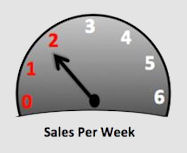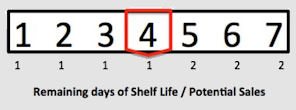|
|


A Fresh Rotation
Finding a compromise between freshness, sales, and
losses.
Submitted by Adam Smith, CFE, CFI
Senior Regional
Asset Protection Manager
Winn Dixie Stores
A busy customer just selected a product from one of your
shelves. The customer quickly made their purchase and
hurried home to be with their family. Everything about
the product looked well – the package didn’t seem
damaged and the store associates were friendly. However,
in this case, we can only hope this customer is planning
to use the product immediately, because it has an
expiration date of today.
In some cases, the customer may notice the expired
product before it is consumed. Other times, the customer
may consume the product without ever checking the
expiration date. At any rate, this sale has the
potential of a negative experience for the customer.
While this scenario may result in a negative experience,
the store did not do anything wrong. Laws and policies
allow the sale of product up to the expiration date.
Moreover, many products are safe to consume several days
after their expiration or sale by date. However, many
customers will not use them. A customer-focused
organization will seek to reduce negative experiences
for their customers regardless of whether the practice
is in-line with regulations.
The first step is to understand the implications of
reducing the amount of days up to the expiration of
products available to customers.
The Close Date
The purpose of leaving close-dated product on the shelf
is to sell it. However, this begs the question of how
many units could be sold. Put another way, what stands
to be gained by leaving the product on the shelf until
its expiration? Yogurt is a good test case since it has
a relatively short shelf life. The average case of
yogurt contains 12 units with an average shelf life of
28 days. Therefore, any yogurt selling 3 or more units
per week will not be affected by expiration dates, as
long as orders are placed appropriately.
 Only varieties selling 2 or less units per week will be
affected by the expirations date. Sales of two per week
would leave four to expire and sales of one per week
would leave eight units to expire. Under normal
operations, these expired units would be available for
sale up to the very last day. Only varieties selling 2 or less units per week will be
affected by the expirations date. Sales of two per week
would leave four to expire and sales of one per week
would leave eight units to expire. Under normal
operations, these expired units would be available for
sale up to the very last day.
Taking it a step further, we can see that there are very
few sales to gain in the last few days of the product’s
life. Since slow sales are the reason that the product
is available to expire, these products will generate
very few sales in the final days of shelf life. A
product selling two units per week represents the
worst-case scenario, since selling any more would not
cause expiration. In this scenario, a product selling
two units per week will average only one sale up to four
days before expiration. Therefore, leaving the product
on the shelf up to the sell by date will sell only one
unit. The figure below illustrates that the optimum
point to pull close dated product is four days before
expiration.
 By pulling the close-dated product four days prior to
expiration, hardly any sales are sacrificed and a
negative customer experience is adverted. The reality is
that slow-moving products are destined to be pulled at
some point, and pulling them a few days early does not
significantly increase the amount of discards. By pulling the close-dated product four days prior to
expiration, hardly any sales are sacrificed and a
negative customer experience is adverted. The reality is
that slow-moving products are destined to be pulled at
some point, and pulling them a few days early does not
significantly increase the amount of discards.
Taking Up Space
Slow moving products may be offered by a store to grow a
product line or promote variety. At the same time, these
products are destined to expire. In some cases, very few
units will sell. Some slow moving products do nothing
more than take up space on a shelf.
Since retailers generally avoid empty spaces on their
shelves, leaving slow movers on the shelf may be serving
a purpose. In extreme cases, a negative customer
experience would never occur because of the lack of
sales in a slow moving product. Pulling these products
early will result in increased losses with very little
upside.
In the example of a case of yogurt with twelve units,
pulling the product four days early represents 14% of
the products shelf life. Therefore, we could expect
losses on this product to increase by 14%. However, this
example would be a worst-case scenario since it assumes
just-in-time delivery of new product.
Dilemma
This can present a dilemma for slow moving product. Few
retailers would mind sacrificing the sale of one unit to
avoid negative customer experiences; however, a 14%
increase in losses could give pause.
However, the issue does not have to be entirely black
and white. Retailers could carefully monitor slow moving
products, removing them as needed. Additionally,
suppliers should have some amount of accountability
relating to the increased losses needed to rotate
products early.
Compromise
The close-date issue may seem to be a choice between
freshness and losses, but there is some room for
compromise. In order for a compromise, the retailer
needs to be up-front with their customers about products
with close-dates. Retailers will want to avoid instances
in which customers purchase products assumed to be
fresh, but discover a close-date after the purchase.
This can be done by reducing the price of a product when
it is four days from expiration. Reducing close-dated
products is a practice that has been around for a long
time, but the intention is usually to avoid losses.
However, this practice also alerts customers to
close-dated products. Some customers may avoid the
products, but others may purchase them to take advantage
of savings. In either case, the retailer is being honest
about the freshness of the product.
Unfortunately, reducing close-dated products is not
without flaws. There may be times in which a customer
intends to pay full-price for a product, but decides to
take advantage of a reduced close-dated product. This
could result in unintended down selling. Moreover,
diverting full-price sales could exacerbate the losses
of a slow-moving product. Unfortunately, it would be
very difficult to fully understand how many times this
happens, and how much it affects the losses of a
product.
The Bottom Line
Whether it’s taking losses earlier or reducing
close-dated products, being up-front with customers
about the freshness of products is important. Any
company dealing with perishable goods should have a
strategy in place to avoid the bait-and-switch feeling a
customer gets when they unknowingly purchase a
close-dated product. |
|
|
What's Happening?
Coming in 2012:
Keyword/Phrase Search
Research Capability
Mobile App's
LP Show Coverage
The Top 10
 |
|